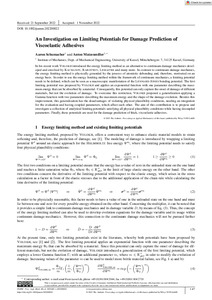Datum
2023-03-24Schlagwort
510 Mathematik 620 Ingenieurwissenschaften SchadensmechanikKlebstoffKontinuumsmechanikViskoelastizitätMetadata
Zur Langanzeige
Aufsatz

An Investigation on Limiting Potentials for Damage Prediction of Viscoelastic Adhesives
Zusammenfassung
In his recent work VOLOKH introduced the energy limiting method as an alternative to continuum damage mechanics developed and envolved by KACHANOV, RABOTNOV, LEMAITRE and many more. In contrast to continuum damage mechanics, the energy limiting method is physically grounded by the process of atomistic debonding and, therefore, motivated on an energy basis. In order to use the energy limiting method within the framework of continuum mechanics, a limiting potential needs to be defined, which can be seen as a macroscopic manifestation of the LENNARD-JONES bonding potential. The first limiting potential was proposed by VOLOKH and applies an exponential function with one parameter describing the maximum energy that can be absorbed by a material. Consequently, this potential can only capture the onset of damage of different materials, but not the evolution of damage. To overcome this restriction, VOLOKH proposed a generalization applying a Gamma function with two parameters describing the maximum energy and the shape of the damage evolution. Besides this improvement, this generalization has the disadvantages of violating physical plausibility conditions, needing an integration for the evaluation and having coupled parameters, which affect each other. The aim of this contribution is to propose and investigate a collection of analytical limiting potentials satisfying all physical plausibility conditions while having decoupled parameters. Finally, these potentials are used for the damage prediction of thick, viscoelastic adhesives.
Zitierform
In: Proceedings in applied mathematics and mechanics : PAMM Volume 22 / Issue 1 (2023-03-24) eissn:1617-7061Förderhinweis
Gefördert im Rahmen des Projekts DEALZitieren
@article{doi:10.17170/kobra-202304197841,
author={Schumacher, Aaron and Matzenmiller, Anton},
title={An Investigation on Limiting Potentials for Damage Prediction of Viscoelastic Adhesives},
journal={Proceedings in applied mathematics and mechanics : PAMM},
year={2023}
}
0500 Oax
0501 Text $btxt$2rdacontent
0502 Computermedien $bc$2rdacarrier
1100 2023$n2023
1500 1/eng
2050 ##0##http://hdl.handle.net/123456789/14600
3000 Schumacher, Aaron
3010 Matzenmiller, Anton
4000 An Investigation on Limiting Potentials for Damage Prediction of Viscoelastic Adhesives / Schumacher, Aaron
4030
4060 Online-Ressource
4085 ##0##=u http://nbn-resolving.de/http://hdl.handle.net/123456789/14600=x R
4204 \$dAufsatz
4170
5550 {{Schadensmechanik}}
5550 {{Klebstoff}}
5550 {{Kontinuumsmechanik}}
5550 {{Viskoelastizität}}
7136 ##0##http://hdl.handle.net/123456789/14600
<resource xsi:schemaLocation="http://datacite.org/schema/kernel-2.2 http://schema.datacite.org/meta/kernel-2.2/metadata.xsd"> 2023-04-19T12:38:24Z 2023-04-19T12:38:24Z 2023-03-24 doi:10.17170/kobra-202304197841 http://hdl.handle.net/123456789/14600 Gefördert im Rahmen des Projekts DEAL eng Attribution-NonCommercial-NoDerivatives 4.0 International http://creativecommons.org/licenses/by-nc-nd/4.0/ 510 620 An Investigation on Limiting Potentials for Damage Prediction of Viscoelastic Adhesives Aufsatz In his recent work VOLOKH introduced the energy limiting method as an alternative to continuum damage mechanics developed and envolved by KACHANOV, RABOTNOV, LEMAITRE and many more. In contrast to continuum damage mechanics, the energy limiting method is physically grounded by the process of atomistic debonding and, therefore, motivated on an energy basis. In order to use the energy limiting method within the framework of continuum mechanics, a limiting potential needs to be defined, which can be seen as a macroscopic manifestation of the LENNARD-JONES bonding potential. The first limiting potential was proposed by VOLOKH and applies an exponential function with one parameter describing the maximum energy that can be absorbed by a material. Consequently, this potential can only capture the onset of damage of different materials, but not the evolution of damage. To overcome this restriction, VOLOKH proposed a generalization applying a Gamma function with two parameters describing the maximum energy and the shape of the damage evolution. Besides this improvement, this generalization has the disadvantages of violating physical plausibility conditions, needing an integration for the evaluation and having coupled parameters, which affect each other. The aim of this contribution is to propose and investigate a collection of analytical limiting potentials satisfying all physical plausibility conditions while having decoupled parameters. Finally, these potentials are used for the damage prediction of thick, viscoelastic adhesives. open access Schumacher, Aaron Matzenmiller, Anton 7 Seiten doi:10.1002/pamm.202200022 Schadensmechanik Klebstoff Kontinuumsmechanik Viskoelastizität publishedVersion eissn:1617-7061 Issue 1 Proceedings in applied mathematics and mechanics : PAMM Volume 22 false e202200022 </resource>
Die folgenden Lizenzbestimmungen sind mit dieser Ressource verbunden:


